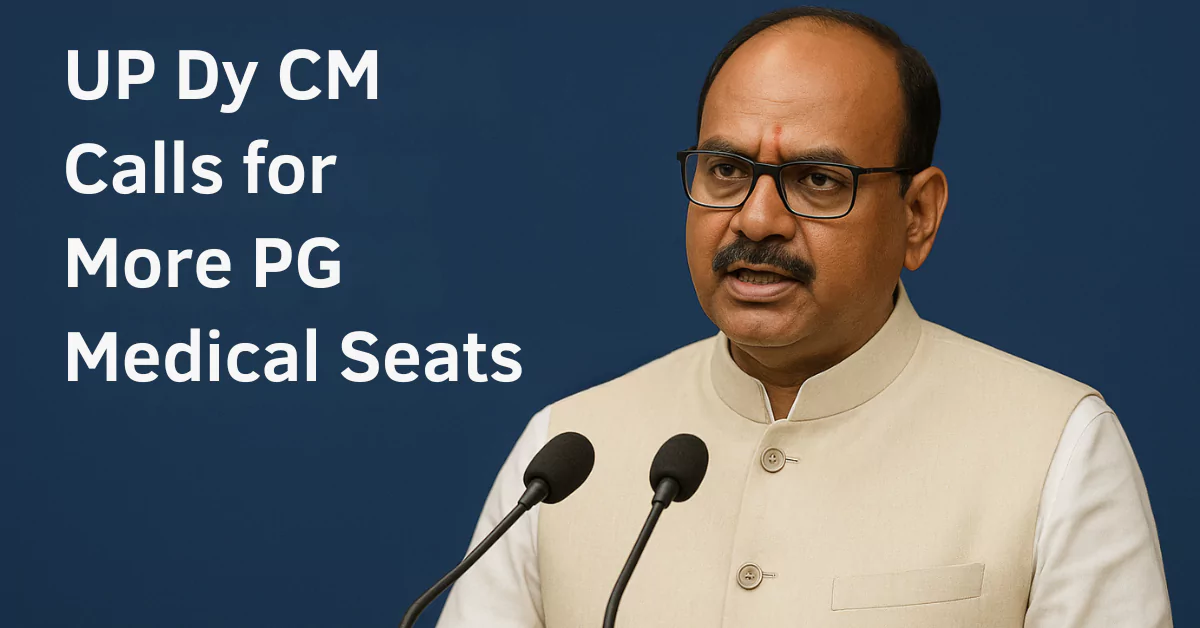Lucknow, UP: Uttar Pradesh Deputy Chief Minister Brajesh Pathak has urged for an increase in postgraduate (PG) medical seats across the state. The appeal comes at a time when thousands of MBBS graduates in Uttar Pradesh face limited opportunities for specialist training due to an insufficient number of PG medical seats.
Speaking at a medical education summit in Lucknow, Pathak emphasised that while the number of undergraduate medical seats has grown impressively, the postgraduate infrastructure remains stagnant.
“We are producing a large number of MBBS doctors every year, but our postgraduate capacity remains insufficient. This bottleneck not only limits career growth for students but also affects the availability of specialists in government hospitals,” he stated.
According to the National Medical Commission (NMC), Uttar Pradesh currently has around 3,378 PG medical seats (MD/MS/Diploma), a figure that falls well short of the demand generated by 9,253 MBBS seats in the state.
MBBS-PG Imbalance
India’s medical education system faces a similar issue at the national level:
| Level | Total Seats (2024-25) |
| MBBS (UG) | 1,18,000 |
| PG (MD/MS/Diploma) | 73,000 |
While UG seats have nearly doubled in the last decade, PG seats haven’t kept pace, leading to excessive competition and a growing number of MBBS graduates forced to wait, go abroad, or shift careers.
NEET UG 2025: Record Turnout Signals Systemic Stress
Held on May 4, 2025, NEET UG 2025 saw around 23 lakh candidates appearing. And it is continuously increasing year by year. The National Testing Agency (NTA) declared the results on June 14, with no perfect scores this year. The highest NEET score was 686, resulting in a slight dip in cut-offs across categories such as General and EWS.
The result has now triggered an intense All India Quota (AIQ) counselling process, led by the Medical Counselling Committee (MCC). State counselling for 85% of seats, including in Uttar Pradesh, is already underway.
Medical Specialist Shortage
Experts have repeatedly highlighted the UG-PG seat gap as a key factor contributing to India’s shortage of medical specialists, particularly in rural and semi-urban government hospitals. According to a recent study by the Indian Public Health Foundation:
- Over 60% of India’s community health centres (CHCs) lack even one specialist doctor.
- Many MBBS graduates are unable to practice independently due to limited clinical exposure and specialisation.
UP for PG Expansion
Deputy CM Brajesh Pathak’s demand aligns with broader national efforts to reform medical education. His key proposals include:
- Upgrading existing district hospitals into PG teaching hospitals.
- Incentivising private colleges to expand PG capacity through grants and PPP models.
- Introducing bond-based PG admissions in government institutions to ensure rural service post-training.
“If we want to retain talent and ensure equitable health services in both urban and rural regions, increasing PG seats is a must,” he emphasized.
What India Can Learn and Implement
Medical experts recommend the following measures:
- Set PG seat targets proportional to MBBS intake across states.
- Ensure mandatory PG programs in every government medical college.
- Create a national medical manpower strategy to forecast specialist needs and seat distribution.
As India moves toward the expansion of medical education access through NEET and new medical colleges, the lack of PG seats is emerging as the next critical bottleneck. Uttar Pradesh’s call for a seat hike, led by Deputy CM Brajesh Pathak, serves as a wake-up call for policymakers.
Scaling up postgraduate medical education is no longer optional; it is central to India’s healthcare and academic future.


